
A locomotive or engine is a rail transport vehicle that provides the motive power for a train. If a locomotive is capable of carrying a payload, it is usually rather referred to as a multiple unit, motor coach, railcar or power car; the use of these self-propelled vehicles is increasingly common for passenger trains, but rare for freight trains.
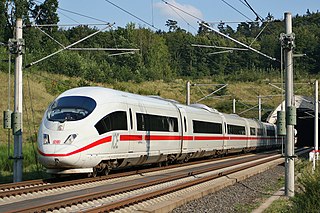
A multiple-unit train or simply multiple unit (MU) is a self-propelled train composed of one or more carriages joined, which when coupled to another multiple unit can be controlled by a single driver, with multiple-unit train control.

In rail transport, distributed power (DP) is a generic term referring to the physical distribution—at intermediate points throughout the length of a train—of separate motive power groups. Such "groups" may be single units or multiple consists, and are remotely controlled from the leading locomotive. The practice allows locomotives to be placed anywhere within the length of a train when standard multiple-unit (MU) operation is impossible or impractical. DP can be achieved by wireless or wired (trainlined) means. Wired systems now provided by various suppliers use the cabling already extant throughout a train equipped with electronically controlled pneumatic brakes (ECP).

Brake van and guard's van are terms used mainly in the UK, Ireland, Australia and India for a railway vehicle equipped with a hand brake which can be applied by the guard. The equivalent North American term is caboose, but a British brake van and a caboose are very different in appearance, because the former usually has only four wheels, while the latter usually has bogies. German railways employed brakeman's cabins combined into other cars.

Multiple-unit train control, sometimes abbreviated to multiple-unit or MU, is a method of simultaneously controlling all the traction equipment in a train from a single location—whether it is a multiple unit comprising a number of self-powered passenger cars or a set of locomotives—with only a control signal transmitted to each unit. This contrasts with arrangements where electric motors in different units are connected directly to the power supply switched by a single control mechanism, thus requiring the full traction power to be transmitted through the train.
Rail transport terms are a form of technical terminology applied to railways. Although many terms are uniform across different nations and companies, they are by no means universal, with differences often originating from parallel development of rail transport systems in different parts of the world, and in the national origins of the engineers and managers who built the inaugural rail infrastructure. An example is the term railroad, used in North America, and railway, generally used in English-speaking countries outside North America and by the International Union of Railways. In English-speaking countries outside the United Kingdom, a mixture of US and UK terms may exist.

The InterCity 125 or High Speed Train (HST) is a diesel-powered high-speed passenger train built by British Rail Engineering Limited between 1975 and 1982. A total of 95 sets were produced, each comprising two Class 43 power cars, one at each end, and a rake of seven or eight Mark 3 coaches. The name is derived from its top operational speed of 125 mph (201 km/h). At times, the sets have been classified as British Rail Classes 253, 254 and 255.
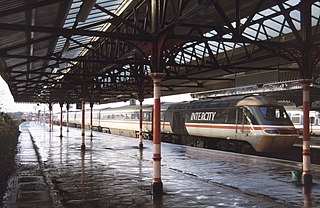
InterCity was a brand name introduced by British Rail in 1966 for its long-haul express passenger services.
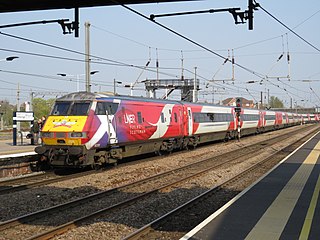
A Driving Van Trailer (DVT) is a British purpose-built control car railway vehicle that allows the driver to operate with a locomotive in push-pull formation from the opposite end of a train. A key benefit of operating trains with DVTs is the requirement for fewer locomotives; for example, a second locomotive would otherwise have to join at the other end of the train after arrival at terminal stations to lead the train's onward journey.

A Driving Brake Standard Open (DBSO) is a type of railway carriage in Great Britain, converted to operate as a control car; this is not to be confused with DVTs, such as those in InterCity 225 sets. Fourteen such vehicles, numbered 9701 to 9714, were converted from Mark 2F Brake Standard Open carriages. Modifications included adding a driving cab and TDM equipment to allow a locomotive to be driven remotely. Using a system known as push–pull, the driver in the DBSO can drive the locomotive, even though it is at the opposite end of the train.

A bank engine, banking engine, helper engine or pusher engine is a railway locomotive that temporarily assists a train that requires additional power or traction to climb a gradient. Helpers/bankers are most commonly found in mountain divisions, where the ruling grade may demand the use of substantially greater motive power than that required for other grades within the division.
Push–pull is a configuration for locomotive-hauled trains, allowing them to be driven from either end of the train, whether having a locomotive at each end or not.

In rail transport, the expression power car may refer to either of two distinct types of rail vehicle:
This article contains a list of jargon used to varying degrees by railway enthusiasts, trainspotters, and railway employees in the United Kingdom, including nicknames for various locomotives and multiple units. Although not exhaustive, many of the entries in this list appear from time to time in specialist, rail-related publications. There may be significant regional variation in usage.

British Rail's Class 27 comprised 69 diesel locomotives built by the Birmingham Railway Carriage and Wagon Company (BRCW) during 1961 and 1962. They were a development of the earlier Class 26; both were originally classified as the BRCW Type 2. The Class 27s were numbered D5347-D5415.
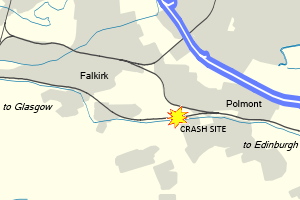
The Polmont rail accident, also known as the Polmont rail disaster, occurred on 30 July 1984 to the west of Polmont, near Falkirk, in Scotland. A westbound push-pull express train travelling from Edinburgh to Glasgow struck a cow which had gained access to the track through a damaged fence from a field near Polmont railway station, causing all six carriages and the locomotive of the train to derail. 13 people were killed and 61 others were injured, 17 of them seriously. The accident led to a debate about the safety of push-pull trains on British Rail.

The British Rail Class 126 diesel multiple unit was built by BR Swindon Works in 1959/60 to work services from Glasgow to Ayrshire and comprised 22 3-car sets and were a development of the earlier Swindon-built trainsets that had been introduced in 1955 to work the Edinburgh Waverley - Glasgow Queen St services. These vehicles formed the first Inter City service to be operated by diesel units in Great Britain.
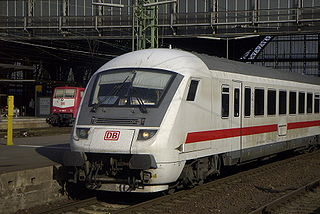
A control car, cab car, control trailer, or driving trailer is a non-powered rail vehicle from which a train can be operated. As dedicated vehicles or regular passenger cars, they have one or two driver compartments with all the controls and gauges required to remotely operate the locomotive, including exterior locomotive equipment such as horns, bells, ploughs, and lights. They also have communications and safety systems such as GSM-R or European Train Control System (ETCS). Control cars enable push-pull operation when located on the end of a train opposite its locomotive by allowing the train to reverse direction at a terminus without moving the locomotive or turning the train around.
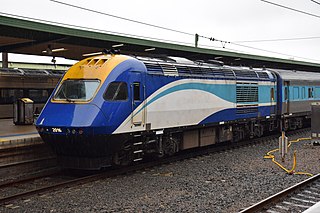
The New South Wales XPT is a class of diesel-powered passenger trains built by Comeng and ABB. Based on the British Rail-designed High Speed Train, each XPT set comprises two XP power cars in a push-pull configuration and, between them, between four and seven passenger carriages.

The Córas Iompair Éireann (CIÉ) 2600 Class were Associated Equipment Company (AEC)–engined diesel multiple units that operated InterCity and suburban services on the CIÉ system between 1952 and 1975. Many were later converted for push–pull operation with diesel locomotives, finally being withdrawn when displaced by the electric Dublin Area Rapid Transit service in the mid-1980s.

















